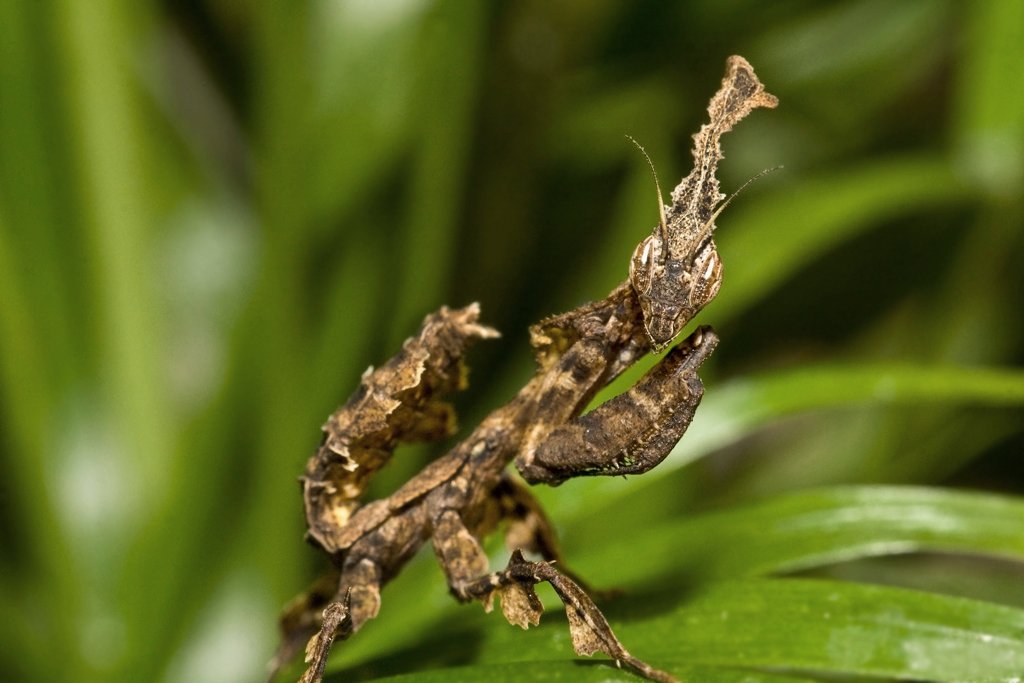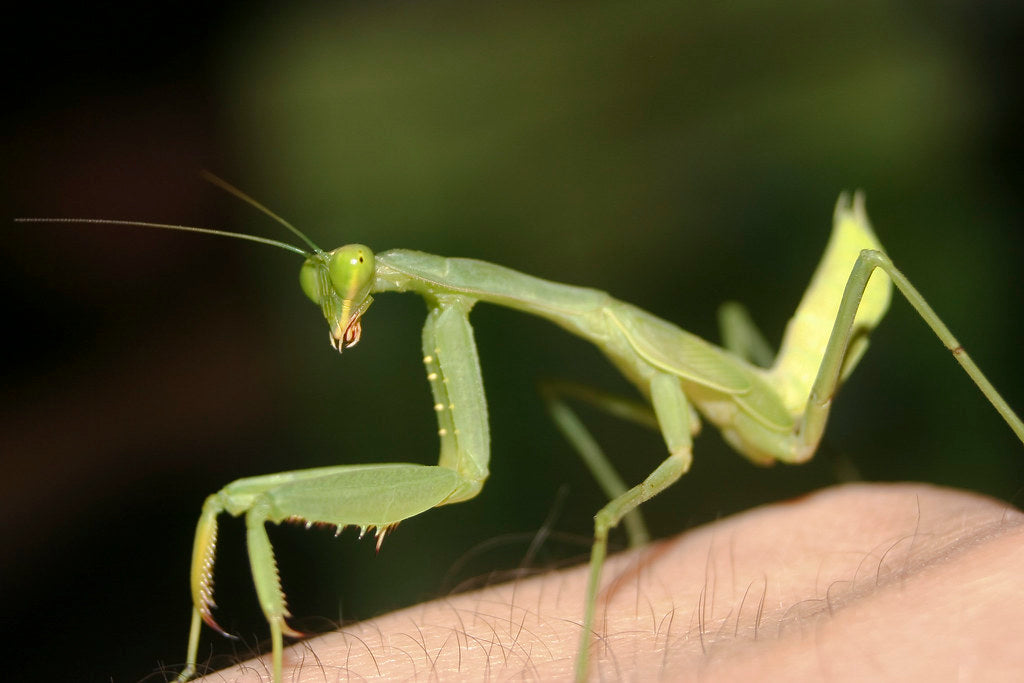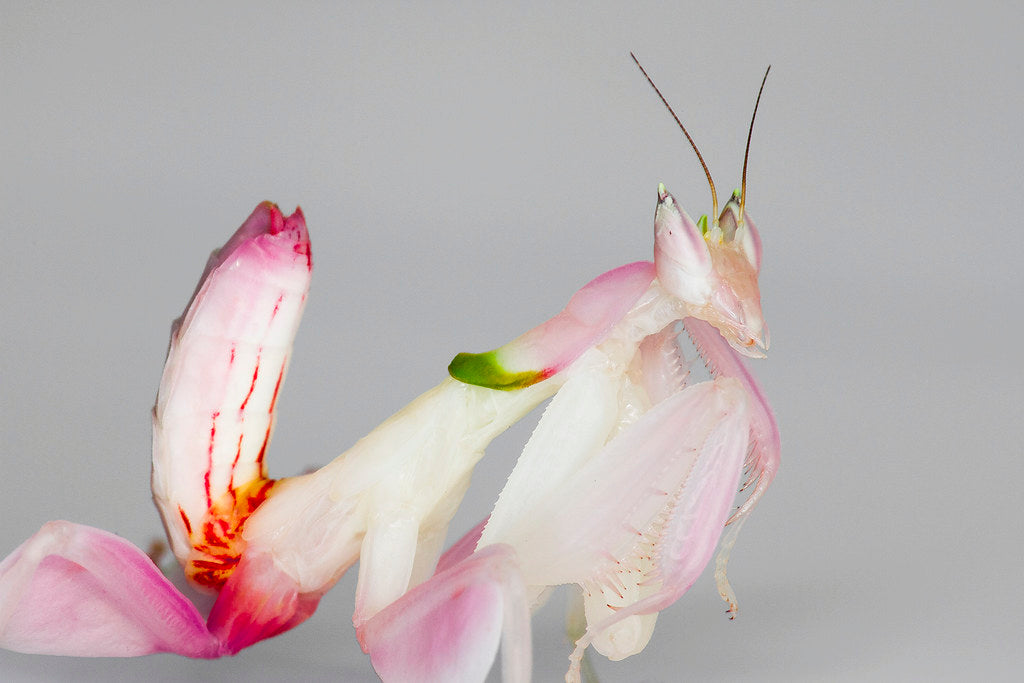The ghost mantis (Phyllocrania paradoxa) is a small, diurnal, carnivorous invertebrate primarily native to the forests of Madagascar and Africa.
Ghost mantises are unique-looking mantises with bodies built for maximum camouflage, and their bodies are shaped to look like they’re made from dead leaves. Their head in particular is topped by a jagged, leaflike crest. Coloring varies from almost black to greenish, and may be influenced by local humidity. Although just 2” long as adults, their extraordinary appearance still makes them eye-catching — if you can find them!
Ghost mantises are intermediate-level pet invertebrates. Total lifespan is up to 7-12 months, depending on sex and the temperature at which it’s kept.
How much space do ghost mantises need?
The general rule with housing praying mantises is that the enclosure length and width should be at least twice that of the mantis, and the height should be at least three times the mantis’ length. 32oz deli cups with fabric vented lids often work well for juveniles. Adults and subadults should be housed in a Kritter Keeper, terrarium, or mesh box measuring at least 4”L x 4”W x 6”H, although larger is optimal.
Ghost mantises are one of the few mantises that can be safely housed in groups with a low risk of cannibalism. For success, avoid overcrowding and maintain groups of roughly the same age. For example, an enclosure with two ghost mantises should be twice as big as the minimum for one.
Do ghost mantises need special lighting?
As long as the mantis’ enclosure is in a room that receives ~12 hours/day of artificial or bright natural light, then additional lighting equipment is unlikely to be necessary. However, if it is being kept in a dark room or the terrarium contains live plants, then ~6500K fluorescent or LED illumination is required.
Do not put mantis enclosures on windowsills, as the sunlight can make temperatures inside the enclosure lethally hot!
What temperatures do ghost mantises need?
Ghost mantises usually do well between 70-80°F, so they can be kept at room temperature. Avoid temperatures above 86°F and below 68°F. Ideal ambient temperature for nymphs is 78°F when possible. Keep track of the temperatures inside your enclosure with a digital thermometer like the Zoo Med Digital Thermometer & Humidity Gauge, with the probe placed in the middle.
It’s best practice to provide a temperature gradient within the enclosure so they can self-regulate their body temperature according to their needs and preference. To prevent potential overheating, avoid using heat sources with mantis nymphs. However, it should be safe to use a heat lamp in a full-size mantis enclosure.
To provide a “basking spot” for your ghost mantis, use a Zoo Med Nano Dome Lamp Fixture with a low-wattage heat bulb like the 25w Zoo Med Nano Basking Spot or similar. Place this on the extreme left or right of the enclosure. Do not place the lamp on top of the mesh, as this can burn your mantis. Instead, suspend the lamp from a Zoo Med Reptile Lamp Stand or similar. The heat lamp should be turned off every night.
Note that heat lamps should not be used with Kritter Keepers or other plastic-top enclosures.
What humidity levels do ghost mantises need?
Humidity is very important for successfully keeping praying mantises as pets, as it helps ensure successful molting and general wellbeing. The ghost mantis requires average humidity levels of 60-90% to stay healthy.
To increase and maintain healthy humidity levels, lightly mist your mantis’ enclosure with a spray bottle at least 2x/day. If you are using a mesh rather than glass/plastic enclosure, then you will likely need to spray more heavily and more often.
Humidity levels should be monitored with a Zoo Med Digital Thermometer & Humidity Gauge or similar with the probe placed in the middle of the enclosure.
What substrate is good for ghost mantises?
Substrate is important to an ghost mantis setup because it helps maintain healthy humidity levels. Many mantis keepers prefer to use a bioactive soil substrate with springtails, isopods, beneficial bacteria and fungi, and live plants because it makes it easier to keep the enclosure clean. However, bioactive can be complicated to get right if you’re new to it, so here are some other substrate options:
- Zoo Med Creatures Eco Soil
- Zoo Med Creature Soil
- Zoo Med ReptiBark
- Eco Earth Plantation Soil
- Exo Terra Forest Bark
- Zilla Bark Blend
You don’t need very much substrate. Depending on the size of the enclosure, 1-2” should be plenty. However, you will need more for the plants’ roots if you plan to create a bioactive setup.
To keep your ghost mantis’ enclosure clean, replace the substrate weekly and completely rinse out the enclosure and décor with hot water. Don’t use soap or disinfectants, as the residue may harm your pet!
What décor can you use in a ghost mantis terrarium?
Ghost mantises like having things to climb and hide behind in their enclosure. This encourages natural behaviors, which makes them more fun to watch, and decreases stress, which in turn increases lifespan. Here are some ideas:
- twigs
- thin vines
- live plants
- artificial foliage
Climbing objects should be arranged at a variety of angles to give your mantis options. Hot glue is excellent for adhering climbing objects and artificial foliage to terrarium walls.
Make sure to leave an open space at the top of the enclosure at least twice the height of your mantis for molting.
What do ghost mantises eat?
Praying mantises are carnivorous, which means that they eat other insects and sometimes even small animals. Avoid overfeeding, as this will shorten your pet’s lifespan. Food should be offered every other day, as much as your mantis will take — they stop eating when they’re full. (Note that praying mantises will refuse food for 1-2 days before molting.)
As a general rule, feeders should be live and no larger than 1/2 of the mantis’ length. Because ghost mantises are ambush hunters and prefer not to chase down their prey, flying insects and insects that can climb up the walls of the enclosure are the best. Options include:
- Fruit flies (D. hydei or D. melanogaster)
- Black soldier flies
- Blue/green bottle flies
- Dubias
- Discoids
- Red runners
- Wax moths
Due to parasite/disease concerns, it’s generally considered best practice to avoid using crickets as feeders for praying mantises. Uneaten prey should be removed from the enclosure after 24 hours.
All feeders should be generously hydrated and gutloaded for at least 24 hours prior to offering to your mantis. This makes sure that your pet gets the best nutrition possible from its meal. Good foods for feeder insects include:
Another way to make sure your mantis gets balanced nutrition is to offer a wide variety of different types of feeder insects.
Do ghost mantises like to be handled?
Generally speaking, it’s best practice not to handle pet invertebrates very much, if at all, and this certainly applies to the ghost mantis. Instead, every day becomes a fun “I Spy” challenge with their expert camouflage!
*This care sheet contains only very basic information. Although it’s a good introduction, please do further research with high-quality sources to obtain additional information on caring for this species.
"Ghost Mantis (Phyllocrania paradoxa)" by Frupus is licensed under CC BY-NC 2.0




Leave a comment
This site is protected by hCaptcha and the hCaptcha Privacy Policy and Terms of Service apply.